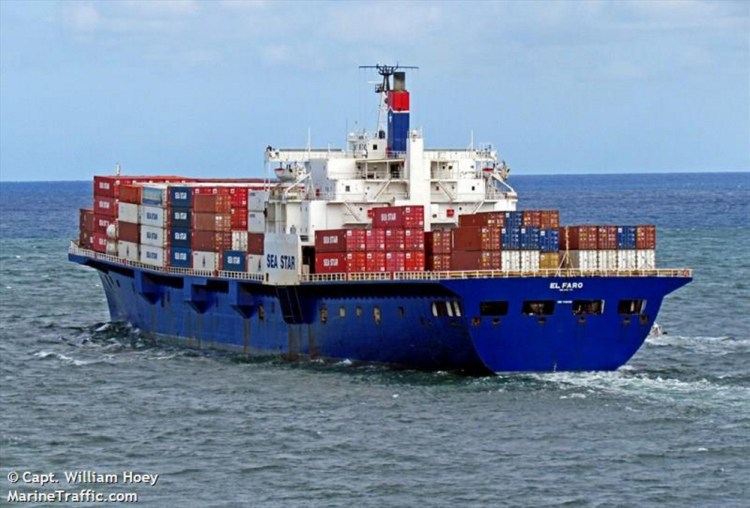The National Transportation Safety Board on Thursday confirmed that it has located the navigation bridge of the sunken container ship El Faro, but the focus of the mission – finding the ship’s voyage data recorder or black box – has encountered another roadblock.
Eric Weiss, a spokesman for the NTSB, said in an interview Thursday evening that the voyage data recorder, which contains important navigational information as well as voice recordings of radio traffic and discussion on the ship’s bridge, broke free from the bridge and remains missing.
The navigation bridge was found about one mile from the rest of the El Faro’s hull. The crew of the Apache located the El Faro on Nov. 3 sitting upright on the bottom of the ocean, in about 30 feet of sediment and three miles below the surface. But the Navy ship also discovered that the bridge had detached from the ship and was missing.
Weiss said the data recorder is likely somewhere in a debris field that stretches 1.5 miles out from the hull of the El Faro. The voyage data recorder was bolted to the top of the bridge. It is contained within a watertight container roughly the size of a large suitcase, Weiss said. Investigators are confident that the device, if it can be found, will still be intact.
“This mission had three goals: to find the vessel, to make sure that the vessel was the El Faro and to find the VDR,” Weiss said. “We are confident that if we can find it (voyage data recorder) it will prove to be useful. It will help us paint an electronic portrait of the last moments before the ship sunk.”
The Navy will use CURV-21, a remotely operated vehicle, to look for and retrieve the data recorder. The ROV is attached to the Navy ship by a tether. A crew operates the ROV from the ship.
The Navy is no longer listening for pings from the ship’s radio distress beacon or EPIRB (Emergency Position Indicating Radio Beacon) because its battery, which is good for about 30 days, has died. The El Faro sank on Oct. 1 during Hurricane Joaquin with four Maine residents on board.
In addition to the ship’s captain, Michael Davidson of Windham, other crew members included: Dylan Meklin, 23, of Rockland, Danielle Randolph, 34, of Rockland, and Michael Holland, 25, of Wilton. Maine Maritime Academy graduate, Mitchell Kuflik of Brooklyn, New York, was also on board the ship when it sank.
David Gallo is director of special projects for the Woods Hole Oceanographic Institution in Woods Hole, Massachusetts. Gallo, who helped lead a 2010 mission to map the Titanic, is an expert on deep sea conditions the Navy will face as they search for the data recorder.
Weiss said the average ocean depth across the planet is about 2.5 miles. El Faro is 3 miles below the surface.
“Three miles is very deep to be working at because they are going to have to do some very intricate work,” Gallo said. Depending on where the data recorder is found, the Navy may have to “surgically cut” through wreckage to retrieve the device.
The El Faro left Jacksonville on Sept. 29 bound for San Juan, Puerto Rico. At the time, the storm was still classified as a tropical storm. On board the ship were 391 containers topside and 294 trailers and vehicles below deck. The National Weather Service issued an advisory upgrading then-Tropical Storm Joaquin to hurricane status while the ship was several hundred miles into its voyage.
The vessel remained on its course through seven additional hurricane advisories over the next 21 hours. On Oct. 1, however, the El Faro lost propulsion and was unable to evade Joaquin, which grew to a Category 4 storm with winds that topped 130 mph, leaving the ship helpless to move from its location as Joaquin bore down.
It sank off the Bahamas.
Send questions/comments to the editors.





Success. Please wait for the page to reload. If the page does not reload within 5 seconds, please refresh the page.
Enter your email and password to access comments.
Hi, to comment on stories you must . This profile is in addition to your subscription and website login.
Already have a commenting profile? .
Invalid username/password.
Please check your email to confirm and complete your registration.
Only subscribers are eligible to post comments. Please subscribe or login first for digital access. Here’s why.
Use the form below to reset your password. When you've submitted your account email, we will send an email with a reset code.